Ijraset Journal For Research in Applied Science and Engineering Technology
- Home / Ijraset
- On This Page
- Abstract
- Introduction
- Conclusion
- References
- Copyright
Detection of Illegal Goods using X-ray Image Enhancement Algorithm
Authors: S. Bhargavi, B. Sadhvik Reddy, T. Sumanth Reddy, T. Sushma, S. Narendra Reddy, P. Sai Kusuma
DOI Link: https://doi.org/10.22214/ijraset.2024.60081
Certificate: View Certificate
Abstract
An X-ray image enhancement technique integrating USM+CLAHE+HAZEREMOVAL and YOLOV2 for object detection is presented to address the problem of colour distortion in CLAHE enhanced airport security X-ray images. Calculating the grayscale images on the R, G, and B channels of the X-ray image and applying CLAHE enhancement to each, then merging the enhanced R, G, and B grayscale images will take place. After that, USM sharpening operation is applied to the CLAHE-enhanced X-ray image, and then it is merged with the original and USM-sharpened images according to the weight. Later haze removal technique is added to obtained results. For detection, YOLOV2 is used. The results of the experiments reveal that the USM+CLAHE+ HAZEREMOVAL algorithm can successfully improve the security X-ray image while also suppressing colour distortion in the enhanced image.
Introduction
I. INTRODUCTION
Security inspection of illegal goods is a challenging task. There are a large number of dangerous goods passing through airports and many other places daily, and it is very hard to inspect each item manually. The security of airports is very important because there are many people who travel in them every day. The main purpose of airport security is to prevent any dangerous item that could harm passengers or staff. The purpose of this project is to develop a novel algorithm for detecting dangerous goods from an X-ray image. The algorithm will aid airport security officers in their inspection of luggage and other packages for threats such as explosives or weapons. This research is motivated by the need for improved security at airports due to the increase in terrorist attacks over the past decade. Airport security is a vital component of the aviation industry, as it is responsible for protecting passengers and their luggage from potentially dangerous goods. One of the most critical aspects of airport security is the use of X-ray machines to scan luggage, which allows security personnel to view the contents of luggage and detect any hazardous items.
However, the quality of X-ray images can be poor, making it challenging for security personnel to identify dangerous goods. This is particularly true for items that are dense, such as metals or electronic devices, which can obscure other items in the luggage. To address this issue, researchers have developed an X-ray image enhancement algorithm that can improve the quality of X-ray images and make it easier for security personnel to identify dangerous goods. The algorithm uses a combination of image processing techniques, such as contrast enhancement, noise reduction, and edge detection, to improve the clarity and visibility of the images.
There are currently few publications on X-ray image enhancement in security, and most domestic and international research on X-ray image enhancement is focused on the medical area and industrial inspection field [1]-[5].and there are few literatures on X-ray image enhancement in security inspection [6]–[8].The most popular picture enhancement technique is histogram equalisation (HE), which has the advantages of a straightforward theory, straightforward application, and high real-time performance.
The Contrast Limited Adaptive Histogram Equalization (CLAHE) algorithm, which is based on the local adaptive histogram enhancement algorithm (Adaptive Histogram Equalization, AHE), effectively suppresses the excessive enhancement of local contrast and the amplification of noise, making it particularly suitable for low-contrast images. Researchers have given the CLAHE algorithm a lot of thought since it combines the benefits of two technologies— adaptive histogram equalisation and restricted contrast. To improve picture details, Sun Dongmei et al. [9] devised an adaptive parameter T that automatically modifies the pixel redistribution range of each image sub-block.
Wang Hong et al. [10] proposed the brightness component of the foggy image using the constrained local histogram algorithm, which improved the brightness and contrast of the foggy image. They used the fuzzy enhancement algorithm to achieve the adaptive contrast enhancement of the global foggy image. In order to enhance the underwater sea cucumber image, Yang Weizhong [11] employed the CLAHE method, which successfully preserved the image's fine features while enhancing the image quality. In order to successfully improve the contrast and edge detail information of the original infrared picture, Liu Yuting et al. [12] coupled the CLAHE method with bilateral filtering algorithm
II. EXISTING SYSTEM
In the digital image application field, images with high contrast and bright colors are the crucial prerequisite for good understanding of the real scenes, such as detection and classification for underwater dam cracks, and multitarget detection under complex environment. The images having a higher contrast level usually display a larger degree of color scale difference as compared to the lower contrast level ones. Light plays a crucial role in generating images of satisfactory quality in photography. Strong light causes an image to have a washed-out appearance; on the contrary, weak light leads to an image that is too dark to be visible.
In these two cases, the contrasts of the images are low and their detailed textures are difficult to discern. The underwater images may lose contrast suffering from degradation due to poor visibility conditions and effects such as light absorption, light reflection, bending of light and scattering of light, which result in dimness and distortion. Furthermore, the poor sensitivity of charge-coupled device /complementary-metal- oxide-semiconductor (CCD/CMOS) sensors leads to images with excessive narrow dynamic ranges and renders their details unclear.
The purpose of image enhancement is a process that allows image features to show up more visibly details and highlight the useful information by making best use of the color presented on the display devices. Image enhancement is used to improve the quality of an image for visual perception of human being. Therefore, it is particularly important to design effective enhancement algorithms to improve contrast and restore color for the degenerated underwater image.
A. Retinex Theory
Recently, Retinex, Homomorphic and Wavelet Multi-Scale techniques have been popular for enhancing images. These methods perform much better than those traditional ones. The Retinex theory is firstly introduced to image enhancement by Edwin et al.
There are some different algorithms based on Retinex theory such as single-scale Retinex (SSR), multi-scale Retinex (MSR), multi-scale Retinex with color restoration (MSRCR), and fast multi-scale Retinex (FMSR) etc. Among them, the MSRCR method proposes to estimate the illumination of the input image using gaussian surround filtering of different scales and conducts enhancement by applying color restoration followed by linear stretching to the logarithm of reflectance.
Though the MSRCR method has demonstrated a strong ability in providing dynamic range compression, color restoration and preserving most of details, a large number of parameters are involved and set empirically, which limit the generalization ability and often result in pseudo halos and unnatural color.
The classical contrast enhancement is Histogram Equalization (HE) which has good performance in ordinary images, such as human portraits or natural images. This method increases the contrast of an image globally by spreading out the most frequent intensity values. However, it suffers from noise amplification in relatively homogeneous regions. HE has been generalized to a local histogram equalization which is known as adaptive histogram equalization (AHE). AHE is based on HE that the adaptive method formulates each histogram of sub-image to redistribute the brightness values of the images. AHE is therefore suitable for improving the local contrast of an image and bringing out more details. Some AHE algorithms have get important progress in suppressing noise and enhancing contrast.
The hybrid cumulative histogram equalization (HCHE) can improve the enhancement effect on hot objects rather than background. The gap adjustment histogram equalization can solve the over-enhancement problem and alleviate the feature loss problem in the dark regions of the image. However, the problem remains the same with the global histogram equalization because of amplifying noise in relatively homogeneous regions.
In order to overcome this problem, contrast limited adaptive histogram equalization (CLAHE) was proposed. CLAHE is a well-known block-based processing, and it can overcome the over amplification of noise problem in the homogeneous region of image with standard histogram equalization. CLAHE algorithm differs from standard HE in the respect that CLAHE operates on small regions in the image, called tiles, and computes several histograms, each corresponding to a distinct section of the image and use them to redistribute the lightness values of the image.
In order to improve contrast and restore color for underwater image captured by camera sensors without suffering from insufficient details and color cast, a fusion algorithm for image enhancement in different color spaces based on contrast limited adaptive histogram equalization (CLAHE) is proposed in this article.
The original color image is first converted from RGB colorspace to two different special color spaces: YIQ and HSI. The color space conversion from RGB to YIQ is a linear transformation, while the RGB to HSI conversion is nonlinear. Then, the algorithm separately operates CLAHE in YIQ and HSI color spaces to obtain two different enhancement images.
The luminance component (Y) in the YIQ color space and the intensity component (I) in the HSI color space are enhanced with CLAHE algorithm.
The CLAHE has two key parameters: Block Size and Clip Limit, which mainly control the quality of CLAHE enhancement image. After that, the YIQ and HSI enhancement images are respectively converted backward to RGB color.
When the three components of red, green, and blue are not coherent in the YIQ-RGB or HSI-RGB images, the three components will have to be harmonized with the CLAHE algorithm in RGB space. Finally, with 4 direction Sobel edge detector in the bounded general logarithm ratio operation, a self-adaptive weight selection nonlinear image enhancement is carried out to fuse YIQ-RGB and HSI-RGB images together to achieve the final fused image. The enhancement fusion algorithm has two key factors: average of Sobel edge detector and fusion coefficient, and these two factors determine the effects of enhancement fusion algorithm.
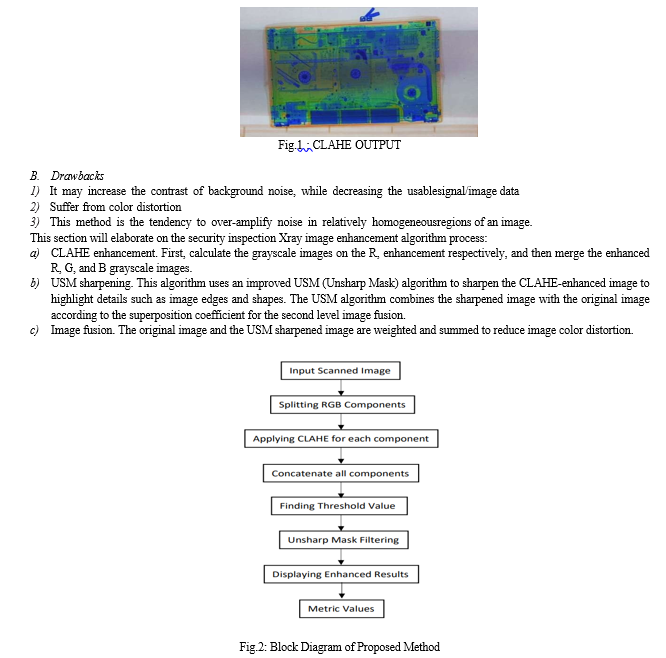
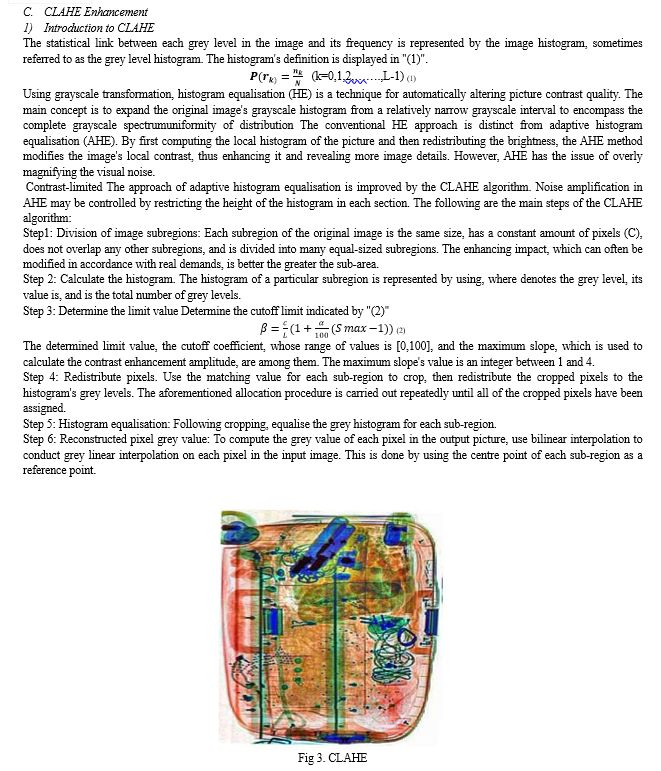
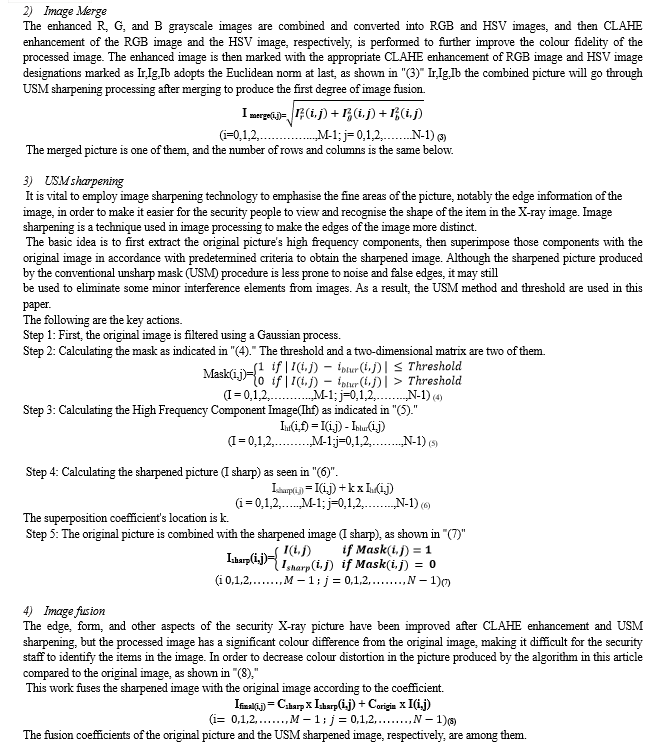

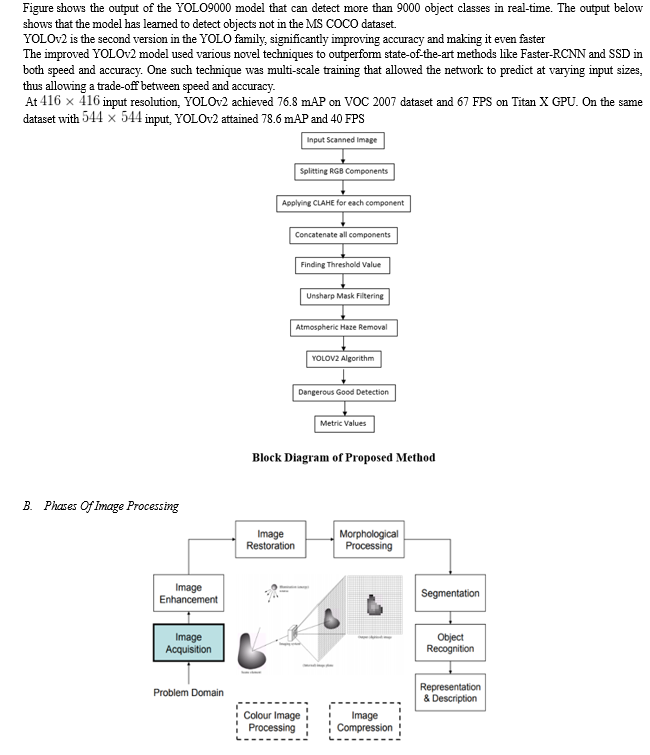

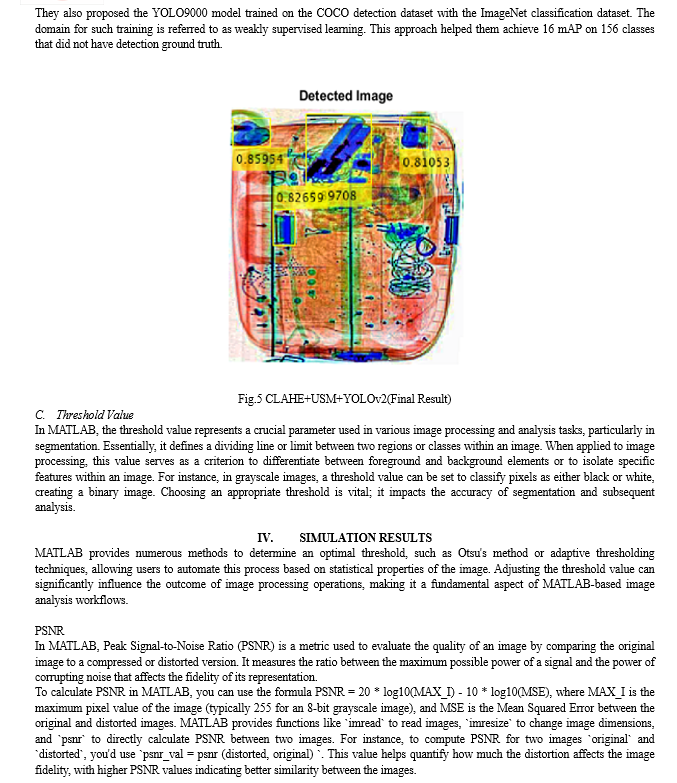
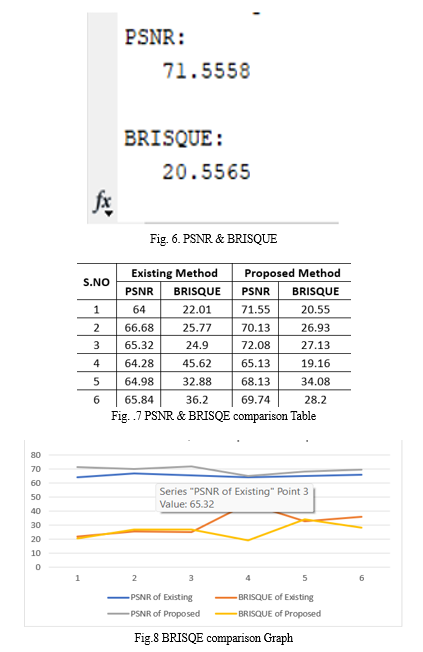
Conclusion
This work investigates the subject of \" In airport security inspection, an X-Ray image enhancement & detection algorithm for dangerous goods \" using Matlab as an analytical framework and to solve the problem of colour distortion in CLAHE enhanced airport security X-ray images, an X-ray image enhancement technique incorporating USM+CLAHE+HAZEREMOVAL and YOLOV2 for object recognition is provided. The grayscale pictures on the R, G, and B channels of the X-ray image will be calculated, and CLAHE enhancement will be applied to each, followed by merging the enhanced R, G, and B grayscale images. The CLAHE-enhanced X-ray image is next subjected to the USM sharpening procedure, which is subsequently blended with the original and USM-sharpened images based on the weight. After that, the collected findings are subjected to a haze removal procedure. YOLOV2 is utilized for detection. The results of the experiments reveal that the USM+CLAHE+ HAZEREMOVAL algorithm can successfully improve the security X-ray image while also suppressing colour distortion in the enhanced image.
References
[1] Saenpaen J, Arwatchananukul S, Aunsri N. A Comparison of Image Enhancement Methods for Lumbar Spine X-ray Image[C]// 2018 15th International Conference on Electrical Engineering/Electronics, Computer, Telecommunications and Information Technology (ECTICON). 2018:798-801. [2] Khan S, See C, Khan A. X-ray image enhancement using boundary division wiener filter and wavelet-based image fusion approach[J]. Journal of Information Processing System, 2016, 12(01): 35–45.. [3] Zhou Chong, Liu Huan, Zhao Ailing,et al. Industrial X-ray image enhancement algorithm based on gradient field [J].Journal of Copmputer Application,2019,39(10):35-45. [4] Xiang Jiankai,Wu Meng,Wang Zhan, et al.. Application of Image Enhancement in X-Ray Photography of Cultural Relics[J]. Laser & Optoelectronics Progress, 2019,56(06):257–262. [5] Koonsanit K, Thongvigitmanee S, Pongnapang N, et al. Image enhancement on digital x-ray images using NCLAHE[C]// Biomedical Engineering International Conference.2017:1-4. [6] Zheng Lintao, Dong Yongsheng, Shi Hengliang. A New Enhancement Algorithm of X-ray Security Inspection Images [J]. Science Technology and Engineering. 2014, 14(23): 252–256. [7] Han Ping,Liu Zexu,He Weikun,Girshick R,etal. An Efficient Twostage Enhancement Algorithm of X-ray Carry-on Luggage Images[J]. Opto-Electronic Engineering , 2011,38(7):99–105. [8] Wang Jian, Pang Yanwei. X-Ray Luggage Image Enhancement Based on CLAHE [J] Journal of Tianjin University(Science and Technology), 2010(03):10–14. [9] Sun Dongmei Lu Jianfeng Zhang Shanqing. The Application of an Improved CLAHE Algorithm in Image Enhancement of Medical Test Strip[J].Chinese Journal of Biomedical Engineering, 2016, 35(04):502-506. [10] Wang Hong, He Xiaohai,Yang Xiaomin. An Adaptive Foggy Image Enhancement Algorithm Based on Fuzzy Theory and CLAHE [J]. Microelectronics & Compute, 2012,29(01):32-34. [11] Yang Weizhong Xu Yinli Qiao Xi,et al. Metho for image intensification of underwater sea cucumber based on contrast-limited adaptive histogram equalizationl[J]. Transactions of the Chinese Society of Agricultural Engineering ,2016,32(06):197-203. [12] Liu Yuting, Chen Zheng, Fu Zhanfang,et al. Infrared image enhancement algorithm based on CLAHE[J]. Laser & Infrared, 2016,46(10):1290-1294.
Copyright
Copyright © 2024 S. Bhargavi, B. Sadhvik Reddy, T. Sumanth Reddy, T. Sushma, S. Narendra Reddy, P. Sai Kusuma. This is an open access article distributed under the Creative Commons Attribution License, which permits unrestricted use, distribution, and reproduction in any medium, provided the original work is properly cited.

Download Paper
Paper Id : IJRASET60081
Publish Date : 2024-04-10
ISSN : 2321-9653
Publisher Name : IJRASET
DOI Link : Click Here
 Submit Paper Online
Submit Paper Online

